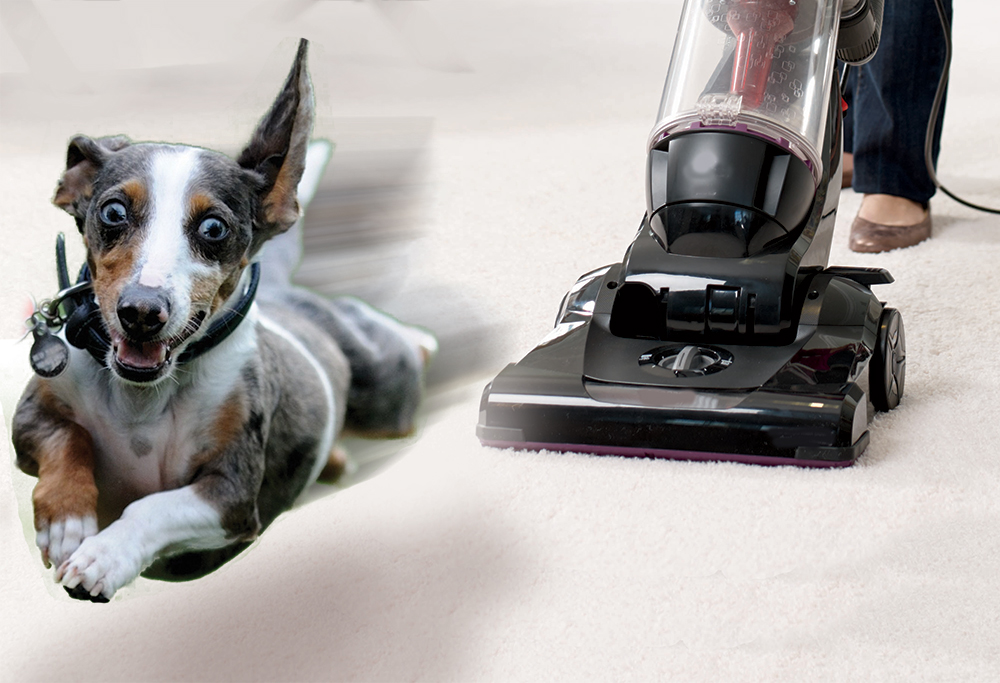Do any of these situations sound familiar?
- When you turn on the vacuum, your pet goes haywire
- When you approach your pet with an electric clipper, they try to run
If either of these scenarios seem familiar, it’s likely that your dog or cat has a fear of vibration. This can be annoying and potentially harmful if your dog takes a chunk out of the vacuum hose or your cat decides to write a very strongly worded letter to the SPCA on your forearm.

Dr. Ian Dunbar, a celebrated veterinarian, trainer and animal behaviorist, once said that “a dog in fear is a dog in pain”. The stress that vibration-based fear places upon your pet can be significant and prolonged. The best thing about anxiety caused by vibration is that it is preventable and treatable. There is no reason for your pet to view grooming day like most people view tax season.
In this article, we are using the examples of the vacuum and electric clippers because these are two of the most common items that produce vibration that pets are likely to come into contact with regularly. However, there are many things that vibrate that your pet might be fearful of.
For pets that are so afraid of vibration that they bite, scratch or have any severe, abnormal reaction, we strongly suggest that you work one-on-one with a qualified animal behaviorist to overcome this problem.
Why Are Pets Sensitive to Vibration?
There are a number of reasons why an animal might be frightened of things that vibrate. While many might be fearful due to a bad experience, others might just be suffering from a lack of exposure to common household items like the washing machine or vacuum. Too many things that vibrate involve uncomfortable situations – ask anyone who hears a dentist’s drill.
Instinct plays a part in this as much as anything; pets are instinctively wary of vibration. Consider the sensitivity of animals to natural disasters, such as earthquakes and tornadoes. There are plenty of reports of animals acting anxious or ‘oddly’ before a natural disaster. We don’t know precisely what enables animals to detect vibration or other changes to their environment, but it is likely an evolutionary adaptation that helped them survive.
Now take that instinct and force it near something vibrating. Without proper acclimatization, you now have a pet in a situation where its hindbrain is telling it, “Get OUT! Get OUT NOW!” while you’re patting it and trying to tell it that the vacuum is not, in fact, a harbinger of the Apocalypse.
Show versus Tell
Since you can’t explain to your pet that a vibrating item won’t hurt them, you can only manage the fear. The difference between us and our pets is that we can understand our fear and control it. Pets can derive some comfort from our presence and calm demeanor, but, as many pet owners can attest, fear can overwhelm even a normally obedient pet.
A pet doesn’t have the ability to understand it when we try to tell it that ‘It’s okay!’. A pet can only be shown, through repeated, positive interactions that the big scary noise isn’t going to hurt it. A pet’s behavior can be modified to substitute a positive behavior for a negative behavior when it is triggered by the noise and sight of something emitting said noise.
Strategies to Deal With Vibration Neuroses
- Don’t expose your pet to vibration or noise! They don’t need to be in the room when you vacuum. It will limit their interactions with vibration and noise to situations where they feel ready.
- Introduce new things gently. This means going out to the car for a “smell visit” a few times before actually starting the car. Gradually expose your pet to the item (turned off).
- Praise and treat for any interaction with the item. Lather, rinse, repeat.
- Don’t punish your pet for expressing fear. This will only further associate the item with negative experiences. Yes, that means not getting mad at your dog when he poops in your shoe after your backyard fireworks show!
- Find your pet’s threshold (where they start showing fear) and work to expand those boundaries. If being in the room with the object doesn’t work, try down the hall.
- Explore clicker training to train new behaviors. Clicker training is a type of training that connects positive reinforcement (food, toys, etc.) with a device that makes a clicking sound. Clicker training can help a pet focus on you instead of vibration and enable you to trigger different behaviors when your pet hears or feels vibration.
- Don’t expect adjustment to happen quickly; retraining takes time.

- Consider other grooming methods such as combs and brushes. One effective grooming tool is Scaredy Cut. The lack of vibration is a distinct advantage when trying to remove or shorten pet hair safely and effectively. Another great non-vibrating grooming tool is the Furminator which will comb out the undercoat.
Some pets may have a low threshold for vibration and noise all their lives. Work on establishing boundaries and positive behavior habits that help you manage your pet’s fear effectively.

